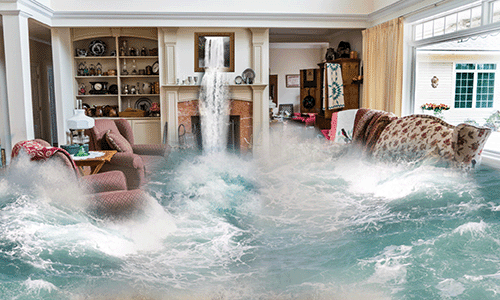By: Resident of Lee County
I didn’t lose my home, but I lost everything in it, when Hurricane Ian pushed three feet of filthy canal sediment and the contents of our neighborhood’s septic tanks through it on September 28, 2022. When I walked into the house on the morning of September 29, it smelled just the way you would expect it to – dead fish, and the aged waste of people and marine animals. My furniture was tossed around like doll house toys, and everything in my house from four feet down (yes, even thick sewer/canal water wicks UP on walls and fabrics) was covered in a black greasy sludge that was dangerous not only for its slick presence across all of my tile flooring, but for its incredibly infectious contents. The beautiful woods of my dining, living room, and bedroom sets, as well as my cherry kitchen cabinetry, were stained and already beginning to bubble and warp, apparently because of the acid content of the sewage, and all but a few items of my clothing had been destroyed in drawers and hanging less than four feet from the floor in my closet. I had virtually nothing.
It was a total loss of the life I had built, but for the shell of my home. But I still count myself lucky. So many lost so much more.
To make matters more complicated, I had just signed a contract to sell the house, less than two weeks prior to the storm. My buyers, too, were in a sticky wicket, having already sold their home in another state, and were renting locally at an exorbitant rate, awaiting our closing. I contacted them through our respective realtors the day after the storm to tell them what had happened, and we discussed their choices:
- They could back out of the contract.
- We could renegotiate the price and they could do the repairs.
- We could hold the price and I would restore the home to its pre-Ian condition (or better).
They loved the house and wanted it, and I knew, having just spent three years transforming it from a sadly neglected building to what my neighbors there called “the prettiest house on the block”, that I would be able to find and vet materials and labor a lot more efficiently than they could, as they were coming from out of state to a totally new area. We agreed on option 3, with the proviso that we would still close as planned on October 31, only a month away, but that I could not guarantee completion of the work by then, and I would do my very best to get it done as rapidly as possible. We did close on October 31, the new owners took possession and lived amid construction for a few more weeks, and on December 14, by agreement, they and I concurred that the work was complete. They love the home, and just rode out Hurricane Helene without damage, thank God. I made new friends in them and we remain in contact today.
I’m telling you all this because I learned some incredibly valuable lessons about handling flood threat and restoration, and I saved an enormous sum of money by moving quickly. Some of my neighbors there have only just completed their repairs from Ian this year, and had significantly more damage and expense than I did because of how quickly mold and rot set in in this subtropical climate.
What follows is a list of those lessons learned, which I hope will be helpful as so many of us now clean up after Helene. My Number One piece of advice: ACT NOW. MOURN LATER. I actually found the busy-ness to be therapeutic.
BEFORE A FLOOD THREAT
There isn’t much you can do to stop three feet of water from entering your home. You would have to be sandbagging for WEEKS prior to thwart that kind of a deluge. But for the future, my best advice for storm warnings where flood is a factor is as follows:
- Get you, your loved ones, your pets, your critical items (prescriptions; critical financial, insurance, and proof-of-ownership papers; weapons; jewelry or other high value items), and your cars out of the area before the storm comes.
That’s it. Get out. And take those items with you. I am, I believe, the only one of my neighbors who did not total at least one vehicle to flood damage. If you read your auto insurance policy, many of you will make the unpleasant discovery that your car is not covered if you do not remove it from a flood zone where a flooding event is predicted. And even if your insurance WILL compensate you for your vehicle, you could go weeks before you get a replacement, unable to do all the other things you must do, to recover your home before mold and rot set in. Finally, as most of us have learned, you never get the replacement value of your car. Often it doesn’t even come close.
Another word about insurance: in your area, insurance advocates will be canvassing for customers. These people specialize in going to bat for you with your insurance company, and with all the work you have in front of you, that will sound tempting. I can only say that I would caution you to get referrals from others who have used them with good results, before you turn your case over to one. It did not work well for me to have anyone going between me and my own insurance company, but that may have more to do with my personality as a driven individual, than anything else. Still, I advise caution. I’m not sure it’s helpful to introduce more middlemen into an already very complex process.
AFTER A FLOOD
I have tried to put this in an order that makes the most sense, although much of it can be done concurrently. For example, you can be cleaning out your garage and ordering materials or vetting contract help when you sit down to take breaks. You may not be able to follow it exactly (e.g., new materials may begin to show up before you can get your garage completely cleaned out), but roughly speaking, this list should help keep you as organized as possible as you undo the damage.
- APPLY FOR FEMA HELP ON LINE. Even if you have no idea what the total loss is, do your best to guesstimate and apply for help. Every dime will count in the coming weeks, and they seem very much to work on a first-come, first-served basis. Get whatever you can. Then, my best advice is, take the money and close down that connection. I advise against taking from them any further assistance other than financial, if you are able to get it. Do not offer them further information or updates, do not accept their housing if you can possibly avoid it, and do not abandon your property for any length of time. I was working every day at my house until the new owners moved in to watch over it, and even after that I was there pretty much every day. Personally, for reasons of my own, I stopped taking calls from FEMA.
- YOUR FIRST PRIORITY IS TO DRY EVERYTHING OUT. Get power in whatever way you can. If the power is not restored within a day or two (and sometimes this is impossible), rent or buy a gas or diesel powered generator as soon as you know that power is not expected to return. Buy one or more constant-drain dehumidifiers, a hose for each one long enough to reach out through your garage or another suitable, lock-able door, and get them running as soon as possible. If/once your A/C is intact and you have power, run the A/C too. Keep the dehumidifiers running throughout the entire process and steps described here. You will be glad you did.
- REMOVE ALL FLOOD-DAMAGED ITEMS FROM THE HOME AS SOON AS POSSIBLE – furniture, belongings, paper, appliances, rugs and carpets, window treatments – everything that got wet. If your flood water was dirty as mine was, don’t bother trying to save any of it. That material does NOT come out of any porous surface, and many non-porous surfaces as well: I ended up throwing away French enamel cookware because it was stained beyond removal even after bathing it all in a plastic tub heavily treated with bleach. Your town or city will arrange for pickup of all items discarded (probably on your front lawn – use contractor bags for small items – it will save you a lot of headache and lawn damage later), but it may take a few weeks because of the sheer volume of people who will be doing the same thing. If you can afford to rent a dumpster, do so as early as possible, because they, too, will become rare and expensive to find except through contractors. Unfortunately, unless you are in a gated community, you can also expect scavengers. I had people I had never seen before whose language was foreign to me traipsing through my yard and pulling everything apart for anything they could find. And they are NOT neat. Every day I had to pick up the things they took off my relatively neat trash pile and simply tossed to the side if they didn’t want it. That brings up another important tip: DO NOT DISCARD ANY IMPORTANT PERSONAL PAPERS OR PERSONAL INFORMATION OUTSIDE. (LET IT DRY IN THE GARAGE AND) BURN IT OR SHRED IT.
- START LINING UP HELP ASAP. I hired a couple of college kids for a few hundred dollars each to haul all my heavy furniture out. I bought construction garbage bags and did all the smaller and lighter items myself. For those of you who are talented and can do your own tear-out (drywall, baseboards, carpeting, etc.), great. I am electricity-declined and didn’t want to mess with all the outlets at low level in my home, so I had a contractor do it – as well as the rebuild. After the tear out I went to a home improvement store and purchased a 5 gallon bucket of a bleach-based anti-mold spray and a 2-gallon pump sprayer. Once the interior studs were dry I went hog wild with the spray on every inch of the exposed walls, up and as far into the remaining untouched drywall / insulation areas as I could get it. [CAUTION: Turn off your electric at the breaker box first.] I did it myself because it saved me a little money, it’s easy to do, and I knew I would probably be more thorough than anyone else would be. I have dangerous mold allergies. It was non-negotiable to kill every spore that could possibly want to land in that house. We gave the mold treatment a couple of days to dry, running the dehumidifiers, before rebuild began. [CAUTION: The mold spray WILL destroy your clothing and shoes. Wear protective gloves and a mask, and only clothes you don’t mind throwing away when you’re done.] Contractors will come calling, probably while you’re working in your home, and may already be wandering your neighborhood passing out cards. Choose wisely, get at least three quotes, get references if you can, negotiate terms and price including a finish date and agreed consequences if that date is not met, and pay in thirds: 1/3 at the beginning, 1/3 at the (calendar and/or work) half way point, and 1/3 upon completion. You may be able to work with your neighbors to all use a single contractor and get a price break – it’s worth looking into. I broke up my work among different people: one contractor did my tear out and rebuild; I hired cleaners twice to go through the house, once when the muck had dried and could be swept and vacuumed up, and a second time once all the work had been completed; an electrical contractor reran wires, replaced boxes, outlets and switches, and I replaced plates myself; another contractor did my kitchen and bath cabinetry replacement; I hired cleaning people early in the process so the toilets would be usable; I hired an interior painter; and I hired a good handyman to cover a number of miscellaneous items such as the lanai rebuild, pressure washing and outside cleanup, exterior touchup paint (the home had just been painted inside and out, but only the outside could be washed and touched up, of course), repair and replacement of the irrigation system parts that got damaged or blown or washed away, and installing appliances when the time came. As you’re vetting these people, exercise caution, and again, get references. As unfortunate as the sloppy scavengers, there will be scam artists, predators, and rip-off artists aplenty offering to do your “contract” work for you. You can avoid them if you’re ready to do some homework. And don’t wait until you need e.g., a painter, to hire one; by the time you do need them, they’ll be booked for months out. Find your people and get them lined up. They’ll typically work with you on start dates.
- SALVAGE WHATEVER YOU CAN / WANT TO KEEP AND SET IT ASIDE FOR RE-USE. As examples: I had just replaced toilets and bathroom fixtures, and there was no need to replace the granite countertops throughout the home, so I saved all of them and reused them over new cabinetry. I could not find anything close to the beautiful cherry wood kitchen cabinetry that was still above the counters (the lower had all been destroyed), and I did not like the look of the “two tone” with something else beneath and the existing cherry above, so I completely replaced the kitchen cabinets. Some of these choices will be necessity; others a matter of what you want.
- START ORDERING SUPPLIES. It will seem like cart-before-horse, but critical cleanup and building supplies will disappear and turn into backorder items within days– starting with generators and bleach. My contractor supplied the drywall for my home as part of his quote, but if you can do your own, estimate what you need (everything one foot above the high water line should be removed and replaced) and order it ASAP, along with nails, tape, and plaster if your contractor isn’t lined up to cover this. I ordered a lot of bleach and mold mitigation formula; electrical boxes, switches, and outlets; replacements for all my interior doors including closets, plus one exterior door; baseboard throughout the house; cabinetry (through my kitchen/bath contractor) and pulls; all new appliances (save microwave) and a hot water heater; vacuum cleaner; rubber gloves; construction garbage bags. Buy a notebook and start lists, and get everything ordered that you know 10,000 other people will be ordering now or very soon.
- CLEAN OUT YOUR GARAGE FIRST. Your garage will become your staging area for the rebuild, it will give you access to whatever tools you have and can use (minus any power tools that may have been damaged, as was the case for me), and as new materials and appliances arrive, you will have a lock-able place to store them.
- BUY OR SALVAGE A COUPLE OF LAWN CHAIRS AND A SMALL TABLE TO KEEP IN A CORNER OF THE GARAGE. It will come in handy for keeping paperwork organized and relaxing with a meal, which you’ll need to do, and in construction there will be nowhere to sit.
One more time: moving fast and drying quickly and thoroughly are your best friends to prevent mold, rot, and further damage or more complex repair issues such as molding insulation or condensation in your attic. For me, I really didn’t have time to think much about the loss of so many personal mementos and memories until much later, but at least it was not compounded by expenses far beyond what they needed to be.








